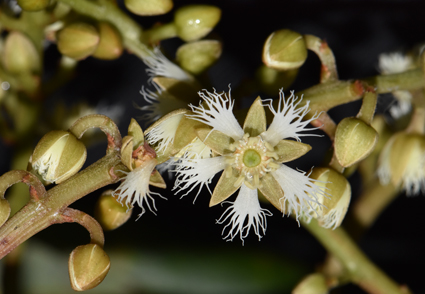Abstract
Based on an ongoing taxonomic study on the genus Elaeocarpus, a new endemic Elaeocarpus species, E. mahamayensis, is described and illustrated from the Knuckles Mountain Range in Matale District (Sri Lanka). The new species had been already noticed by Zmarzty in 2001; during the revision of Elaeocarpus sect. Elaeocarpus in Southern India and Sri Lanka, she referred a herbarium specimen of this plant as “Elaeocarpus sp. B”. The stone of Elaeocarpus mahamayensis is similar to that of E. amoenus, E. coriaceus, E. montanus and E. taprobanicus, but their leaf characters differ. With this new addition, the number of Elaeocarpus species occurring in Sri Lanka is elevated to ten. The conservation status of E. mahamayensis based on the IUCN Red Data category guidelines is determined as Critically Endangered.
References
- Arnnott, W.G.A. (1836) Nova acta physico-medica. Academiae Caesareae Leopoldino-Carolinae Naturae Curiosorum, Pugillus plantarum Indiae orientalis, 18. Breslau and Bonn, 323 pp
- Baba, Y. (2013) Evolution, systematics and taxonomy of Elaeocarpus (Elaeocarpaceae) in Australasia. Doctoral dissertation, James Cook University, 759 pp. https://doi.org/10.25903/2sh7-ym93
- Baba, Y. & Crayn, D. (2012) Elaeocarpus hylobroma (Elaeocarpaceae): a new species endemic to mountain tops in north-east Queensland, Australia. Kew Bulletin 67: 743–750. https://doi.org/10.1007/s12225-012-9398-9
- Baba, Y., Rossetto, M. & Crayn, D.M. (2020) Identifying evolutionary lineages in the Elaeocarpus obovatus complex: population genetics and morphometric analyses support a new subspecies, Elaeocarpus obovatus subsp. umbratilis, from northern Queensland, Australia. Australian Systematic Botany 33 (4): 346–379. https://doi.org/10.1071/sb18054
- Christenhusz, M.J. & Byng, J.W. (2016) The number of known plants species in the world and its annual increase. Phytotaxa 261 (3): 201–217. http://dx.doi.org/10.11646/phytotaxa.261.3.1
- Coode, M.J.E. (2004) Elaeocarpaceae. In: Kubitzki, K. (Ed.) Flowering Plants Dicotyledons: Celastrales, Oxalidales, Rosales, Cornales, Ericales, Springer, Berlin, Heidelberg, pp. 135–144. https://doi.org/10.1007/978-3-662-07257-8_18
- Cupido, C.N. (2003) Systematic studies in the genus Merciera (Campanulaceae): A re-assessment of species boundaries. Adansonia 25 (1): 33–44.
- Don, G. (1831) A general history of the dichlamydeous plants: comprising complete descriptions of the different orders, vol. 1. Gilbert & Rivinton, Printers, London, 559 pp.
- Hammer, Ø., Harper, D.A. & Ryan, P.D. (2001) PAST: Paleontological statistics software package for education and data analysis. Palaeontologia electronica 4: 1–9.
- Hooker, W. (1837) Icones Plantarum, vol. 2. Longman, London, 154 pp.
- Irudhyaraj, D.F. & Ramasubbu, R. (2017) Rediscovery of Elaeocarpus gaussenii Weibel: a little known endemic tree of the Western Ghats of Tamil Nadu, India. Current Science 112 (12): 2372–2374.
- IUCN Standards and Petitions Committee (2022) Guidelines for Using the IUCN Red List Categories and Criteria. Version 15.1 Prepared by the Standards and petitions committee. Available from: https://www.iucnredlist.org/resources/redlistguidelines (accessed 31 January 2023)
- JSTOR Global Plants (2023) Available from: https://plants.jstor.org/ (accessed 15 February 2023)
- Linnaeus, C. (1753) Species plantarum, exhibentes plantas rite cognitas, ad genera relatas, cum differentiis specificis, nominibus trivialibus, synonymis selectis, locis natalibus, secundum systema sexuale digestas. Laurent Salvii, Stockhom, 515 pp. https://doi.org/10.5962/bhl.title.65726
- Masters, M.T. & Hooker, J.D. (1874) Flora of British India. L. Reeve & Co., London, 406 pp.
- Meijer, W. (1995) Elaeocarpaceae. In: Dassanayake, M.D., Fossberg, F.R. & Clayton, W.D. (Eds.) Revised Handbook to The Flora of Ceylon, vol. 9. Amerind Publication Co. Pvt. Ltd., New Delhi, pp. 80–90.
- Ministry of Environment (2020) The National Red List 2020 of Sri Lanka; Conservation Status of the Fauna and Flora. Ministry of Environment, Colombo, Sri Lanka, 59 pp.
- Phoon, S.N. (2015) Systematics and biogeography of Elaeocarpus (Elaeocarpaceae) (Doctoral dissertation, James Cook University).
- POWO (2023) Plants of the World Online. Facilitated by the Royal Botanic Gardens, Kew. Available from: http://www.plantsoftheworldonline.org/ (accessed 4 January 2023)
- Roxburgh, W. (1832) Flora Indica, or Descriptions of Indian Plants, vol. 2. W. Thacker & Co. Calcutta, 597 pp.
- Schlechter, R. (1916) 40. Die Elaeocarpaceen Papuasiens. Botanische Jahrbücher für Systematik, Pflanzengeschichte und Pflanzengeographie 54 (3): 92–155.
- Silva, G.G.N.D., Yakandawala, D.M.D. & Yakandawala, K. (2021) Morphometric analysis of genus Elaeocarpus L. (Elaeocarpaceae) in Sri Lanka. Proceedings of The Peradeniya University International Research Sessions 22: 134.
- Thiers, B. (2023+) Index Herbariorum: A global directory of public herbaria and associated staff. New York Botanical Garden’s Virtual Herbarium. Available from: http://sweetgum.nybg.org/ih/ (accessed 12 July 2023)
- Thwaites, G.H.K. & Hooker, J.D. (1858) Enumeratio plantarum Zeylaniae. Dulau and Co. London, 32 pp.
- Weibel, R. (1972) Deuxc especes nouvelles du genere Elaeocarpus provenant des montagnes du sed del’ Inde. Candollea 27 (1): 17–19.
- Wight, R. (1840) Illustrations of Indian Botany: Or, Figures Illustrative of Each of the Natural Orders of Indian Plants Described in the Author’s Prodromus Florae Peninsulae Indiae Orientalis, vol. 1. J.B. Pharoah, Madras, 84 pp. https://doi.org/10.5962/bhl.title.9603
- Zmarzty, S. (2001) Revision of Elaeocarpus (Elaeocarpaceae) section Elaeocarpus in Southern India and Sri Lanka. Kew Bulletin: 405–447. https://doi.org/10.2307/4110964


